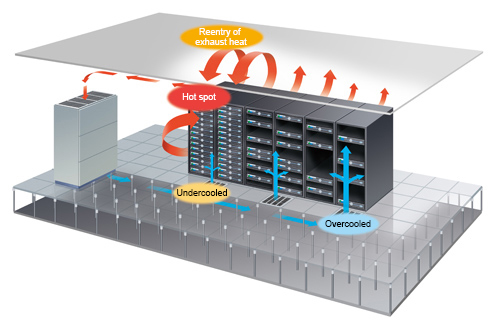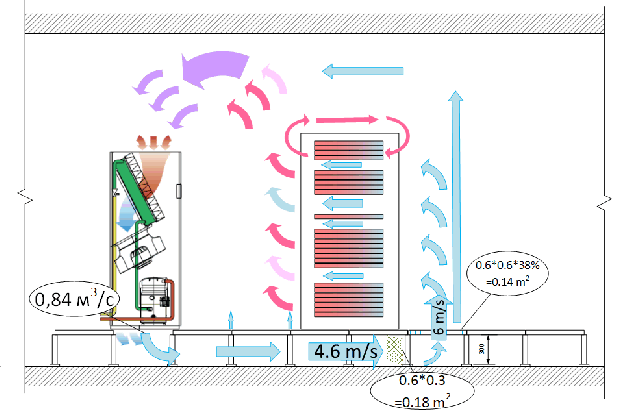
To make it simpler consider one rack in a row in usual raised floor configuration.

Let’s count. Air specific weight is approximately 1,2 kg/m3. Specific heat capacitance is approximately 1 kJ/kg (such precision is enough for our estimations).
Suppose temperature difference is 10 degrees. Then each kilowatt of heat to transfer requires 0,08 m3/s. 5 kW require 0,42 m3/s. What the difference between? It is applicable to all changes of temperature in the room. But details matter.
Suppose CHAH unit makes up 20°C. Then to produce 5 kW of cooling it will need 0,42 m3/s and +30°C of return air.

If under raised floor clearance is 300 mm 0,42 m3/s means 2,3 m/s air speed underfloor. And air speed through 38% perforated tile will be 3 m/s.
Usually at the speed lower than 2 m/s no turbulence problem occurs. Turbulence provides very high flow resistance.
So in this ideal case we can see bottle neck in 38% perforated tile.
The next step is from ideally populated rack to more realistic case.
Suppose half of the air bypassing servers through the rack and above the rack.

To blow the same 5 kW at 5 degrees’ difference twice bigger flow is necessary. The same is about speeds. That means severe turbulence under floor and on perforated tile. Much bigger resistance will require higher power consumption by CRAH fans and this additional heat should be removed.
High-speed stream will go to the ceiling in addition.
As the result we can reach the following limitation below nominal capacity of the CRAH:
This is only one of various effects related to poor separation of hot and cold air. If there are racks with different IT-Load in one row the picture will be more complicated. Lower units may be overheated due to Bernoulli effect. In case of lowering temperature setpoint intensive vapor condensation may occur that provoke huge additional cooling need.
As the result server room with cooling redundancy may run out of N+1 cooling capacity below mean IT-load. Even in case of clean condenser units and properly filled Freon circuits.
The methods to improve air circulation in server room are not rocket science. Install blinding plates into unused units. Install separation walls between cold and hot aisles. And so on.
Our engineers can consult and offer solution for your room.